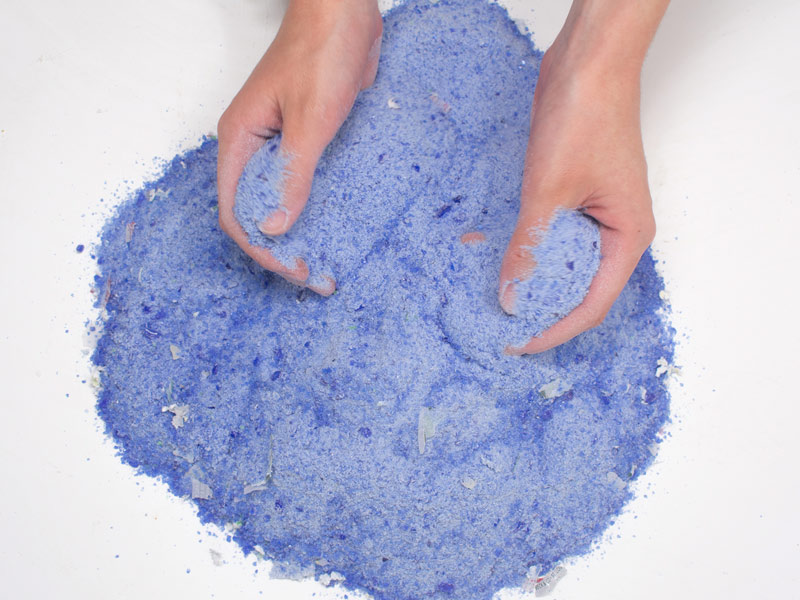
(Photo courtesy of Glass Half Full)
Ground up glass to look like sand and use it to provent sane erosion? Sounds fantastic but Tulane University, working with Glass Half Full is making it a reality.
The “no glass on the beach” rule might get turned on its head, just a bit, now that a team of Tulane University engineers and scientists has received funding to establish a recycling program that uses glass sand to prevent coastal land loss. With the help of more than $700,000 in funding from the National Science Foundation’s Convergence Accelerator Program, the Tulane team will work with the New Orleans-based glass recycling center Glass Half Full to develop a plan to divert glass from landfills and turn it into glass sand products to restore coastal communities and preserve historic sites. Led by Julie Albert, an associate professor in the Department of Chemical and Biomolecular Engineering, the Tulane group is one of 28 multidisciplinary teams that will share in $21 million in NSF funding and compete for more funding to bring their ideas to fruition. Teams will spend the next nine months accelerating their research toward tangible solutions that make a difference. Albert’s project was inspired by a service-learning collaboration between Katie Russell, senior professor of practice in chemical and biomolecular engineering, and Franziska Trautmann, a Tulane chemical engineering graduate and co-founder of Glass Half Full. “People rely on coastal resources for food, water and energy. However, extraction of these natural resources over the last century has led to pollution and coastal land loss,” Albert said. “Protecting and restoring coastal environments, while continuing to support local economies, has never been more urgent. In this networked blue economy approach, new products are also created to generate revenue for operating the glass recycling facilities.”
news.tulane.edu
With two stories about Tulane in the past two days I have to note that my son got his Masters in History there and other than that I have no ties to the university. Glass has to be thrown in the trash as there is no recycling of it and with all the restaurants here this is the best way to get rid of it. If the city can figure out how I can get my glass there easily then more power to them.
The project brings together university researchers from the fields of chemical engineering, civil and environmental engineering, river and coastal engineering, and ecology and evolutionary biology to identify new markets for recycled glass products, determine where recycled glass sand should be used to prevent coastal land loss and ensure that recycled glass sand is safe to use in coastal environments. “The idea here is to collect, process and reuse glass where glass waste is generated,” Albert said. “In our long-term vision, we aim to set up multiple locally operated facilities throughout the state. This structure would not only mitigate transportation costs but also create jobs in support of the local community.” “For the Phase 1 project, we are focusing on coastal communities combatting land erosion and loss in the greater New Orleans area and adjacent parishes. At the same time, we are identifying additional markets for recycled glass sand that would generate revenue to sustain these facilities beyond the grant period.”
The project is also going to work with the indigenous tribes so the Lowlander Center might check to see how they can get involved.
The project will also engage local Native American communities in preserving important cultural sites that are currently threatened by land loss. Additionally, it will create service, research, and training opportunities for local students of all ages to learn about the complex inter-connections between technology, economics, history, and the coastal environment. In addition to Trautmann and Russell, Tulane team members include Vijay John, a professor in the Department of Chemical and Biomolecular Engineering; Ehab Meselhe and Mead Allison, professors in the Department of River-Coastal Science and Engineering; and Assistant Professor Emily Farrer, Associate Professor Sunshine Van Bael, Professor Hank Bart and Professor of Practice Jelagat Cheruiyot from the Department of Ecology and Evolutionary Biology. Assistant Professor Kejun Wen from the Department of Civil and Environmental Engineering at Jackson State University is also on the team. Launched in 2019, the NSF Convergence Accelerator builds upon basic research and discovery to accelerate solutions to national societal challenges. “The curriculum is designed to provide our funded teams the tools to transform their pioneering ideas into a proof of concept, then prototype and finally a solution,” said Douglas Maughan, head of the NSF Convergence Accelerator program. “Teams will also be required to develop partnerships to support solution sustainability and transition to practice.”
A win-win situation as it gets glass out of the trash and helps the beaches. This is what synergy is between academics and industry.



